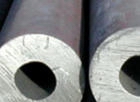 销售部联系方式
销售部联系方式電(diàn)话:021-54192998
電(diàn)话:021-54461708
传真:021-54192997
地址:上海市闵行區(qū)瓶安路505弄32号
邮箱:sales@baoyuansteel.com
网址:www.baoyuansteel.com.cn

INCONEL® nickel-iron-chromium alloy 706 (UNS N09706) is a precipitation-hardenable alloy that provides high mechanical strength in combination with good fabricability. The characteristics of the alloy are similar to those of INCONEL alloy 718 except that alloy 706 is more readily fabricated, particularly by machining. (The properties of alloy 718 are described in the publication “INCONEL alloy 718,” on the website www.specialmetals.com.) The limiting chemical composition of INCONEL alloy 706 is listed in Table 1. The substantial nickel and chromium contents provide good resistance to oxidation and corrosion. The primary precipitation-hardening constituents of the alloy are niobium and titanium. The aluminum content also contributes to the hardening response. The precipitation-hardening system in INCONEL alloy 706 provides the desirable characteristic of delayed hardening response during exposure to precipitation temperatures. That characteristic gives the alloy excellent resistance to postweld strain-age cracking. INCONEL alloy 706 is used for a variety of applications that require high strength combined with ease of fabrication. In the aerospace field, the alloy is used for turbine discs, shafts, and cases; diffuser cases; compressor discs and shafts; engine mounts; and fasteners. In addition to aerospace applications, the alloy is used for turbine discs in large industrial gas turbines. Property values in this publication are given in both United States customary units and the International System of Units (SI). The SI unit of stress is the pascal (Pa), which is equivalent to newton per square meter. The approximate relationship between the pascal and the pound per square inch (psi) is 1 Pa = 0.0001450 psi, or 1 psi = 6,895 Pa. Table 1 - Limiting Chemical Composition, %, of INCONEL alloy 706 Nickel (Plus Cobalt).....................................................39.0-44.0 Chromium....................................................................14.5-17.5 Iron ...............................................................................Balanceb Niobium (plus Tantalum)..................................................2.5-3.3 Titanium...........................................................................1.5-2.0 Aluminum....................................................................0.40 max. Carbon........................................................................0.06 max. Copper........................................................................0.30 max. Manganese .................................................................0.35 max. Silicon .........................................................................0.35 max. Sulfur ........................................................................0.015 max. Phosphorus ..............................................................0.020 max. Boron ........................................................................0.006 max. Cobalta ........................................................................1.00 max. a Determination not required for routine acceptance. b Reference to the ‘balance’ of a composition does not guarantee this is exclusively of the element mentioned but that it predominates and others are present only in minimal quantities.



